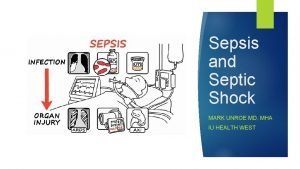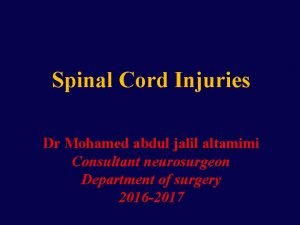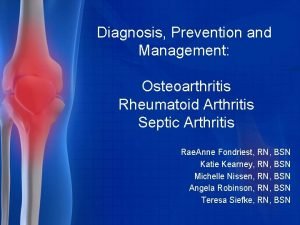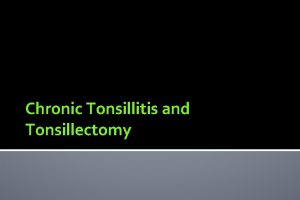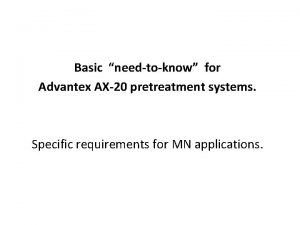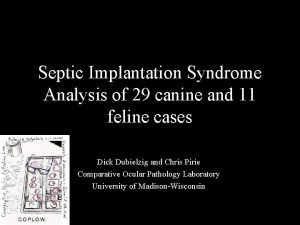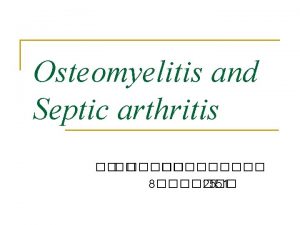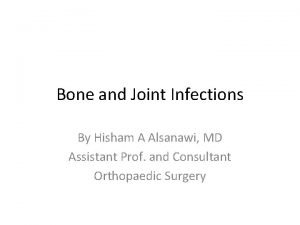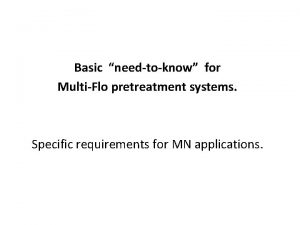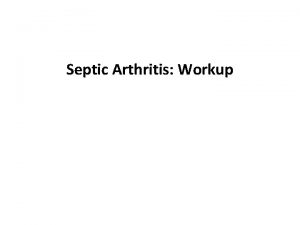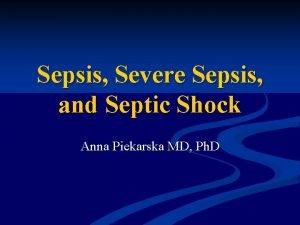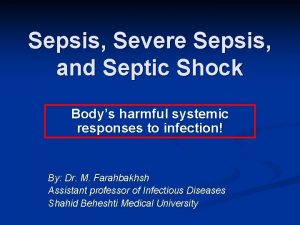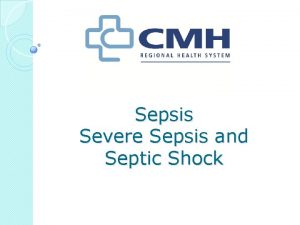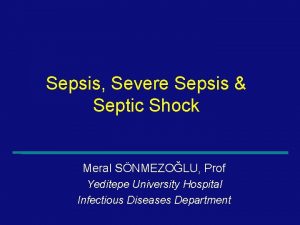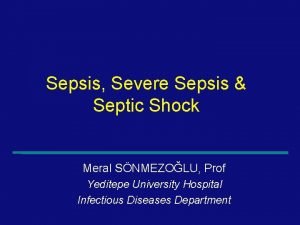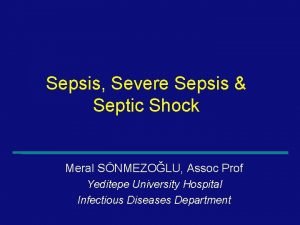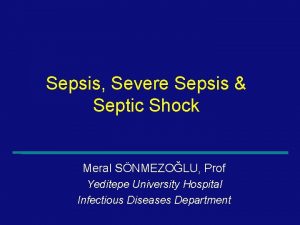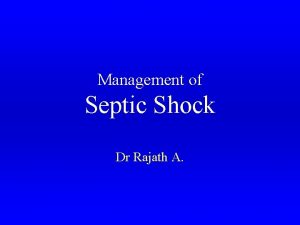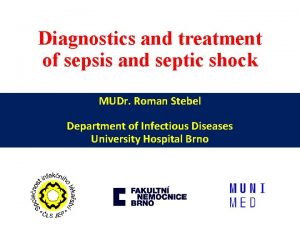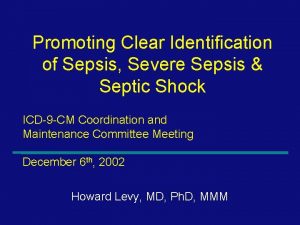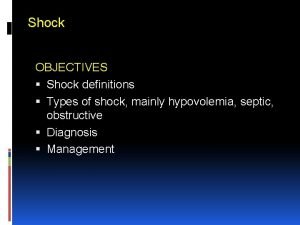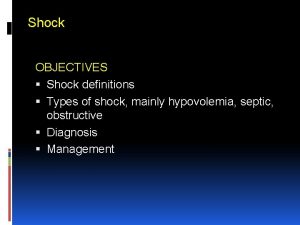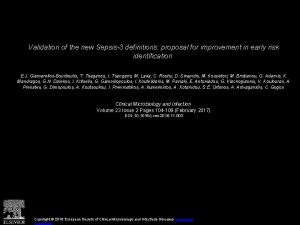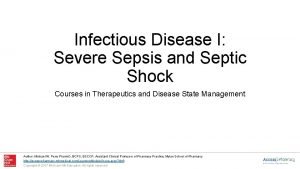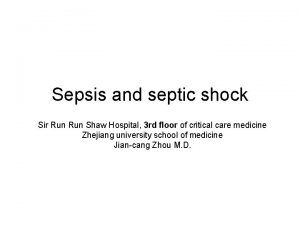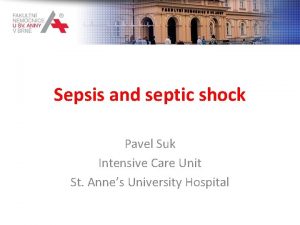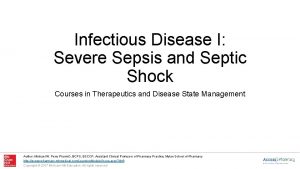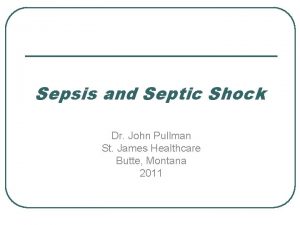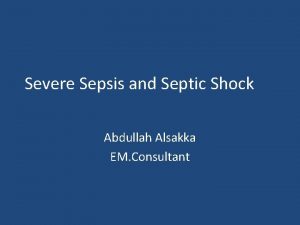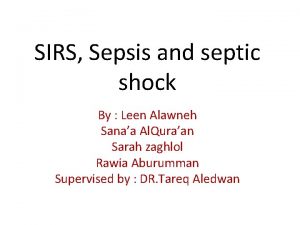Sepsis3 new definitions of sepsis and septic shock































- Slides: 31

Sepsis-3 new definitions of sepsis and septic shock

Outline • A brief overview of sepsis • Introduction to the new Sepsis-3 definitions of sepsis and septic shock* • Interactive bit – design a new sepsis care bundle for your hospital JAMA 2016: 315 (8): 801 -810 February 23


Summary of Sepsis-3

What is ‘sepsis’? Life-threatening organ dysfunction caused by a dysregulated host response to infection

Sepsis The result of the body’s over-response to infection Pathogen Infection Host response ++ Inflammation Loss of homeostasis Organ dysfunction Death Other factors Coagulation / fibrinolysis Endothelial dysfunction

Inflammatory response to infection Pathogen Infection Anti-inflammatory mediators IL-4, IL-10, IL-11, IL-13, IL-1 r Monocyte/ macrophage Pro-inflammatory cytokines Tumor necrosis factor, IL-1, IL-6, IL-8 Neutrophil activation, aggregation, degranulation; release of oxygen free radicals and proteases Platelet activation – aggregation Endothelial damage T-cell IL-2, Interferon- , GM-CSF

Coagulation factors and platelets are consumed faster than they can be replaced.

Therefore: ‘classical’ features of sepsis (classical means advanced stages) • Systemic inflammatory response • Reduced systemic vascular resistance / vasodilatation • Increased capillary permeability • Coagulopathy and microvascular thrombosis • Metabolic (lactic) acidosis • Organ dysfunction

Prevalence and hospital mortality associated with severe sepsis Proportion (%) of admissions to ICU with severe sepsis in the first 24 hours Hospital mortality (%) 70 60 40 30 20 10 15 4 – 1 20 9 – 2 25 4 – 2 30 9 – 3 35 4 – 3 40 9 – 4 45 4 – 4 50 9 – 5 55 4 – 5 60 9 – 6 65 4 – 6 70 9 – 7 75 4 – 7 80 9 – 8 85 4 – 8 9 90 + – 1 9 10 5– 4 0 0– % 50 Age group (years)

The prognostic effect of organ dysfunction in severe sepsis Proportion (%) of admissions to ICU with severe sepsis in the first 24 hours in ICU with (N) organ dysfunctions Hospital mortality (%) 100 80 % 60 40 20 0 1 2 3 4 Number of organ dysfunctions 5

Hospital mortality associated with severe sepsis by APACHE II score Proportion (%) of admissions to ICU with severe sepsis in the first 24 hours in ICU by APACHE II score Hospital mortality (%) 100 % 80 60 40 20 0 0– 4 5– 9 10– 14 15– 19 20– 24 25– 29 30– 34 APACHE II score groups 35– 39 40– 44 45+

Pathogens involved in severe sepsis Gram negative Gram positive Fungal infection 20% 45% Mixed bacterial 19% 3% 10% 3% Other mixed Unconfirmed • Only 60% of severe sepsis/septic shock cases are associated with confirmed infection • Disease progression is similar regardless of causative organism

Video of the microcirculation in sepsis

SIRS is dead – long live q. SOFA! • Respiratory rate > 22/minute • Altered mentation • Systolic blood pressure <100 mm. Hg • Outside ICU this predicts those with a higher mortality

Date of download: 5/9/2016 Copyright © 2016 American Medical Association. All rights reserved.

Date of download: 5/9/2016 Copyright © 2016 American Medical Association. All rights reserved.

How does this relate to NEWS?

Any questions at this point?

What is the Sepsis Six? Despite new research, there is still evidence that care bundles are effective in sepsis.



Sepsis Six – within the first hour survivingsepsis. org/guidel ines sepsistrust. org/clinicaltoolkit/ 1. Oxygen to achieve target sats 2. IV access and blood cultures 3. ABG/VBG to measure lactate 4. Fluid challenges to treat high lactate or low BP 5. IV antibiotics within 1 hour 6. Monitor urine output (catheter/fluid balance)

Early antibiotics matter – or do they?

What happens AFTER you’ve done the Sepsis Six?

Within the first 6 hours • If a patient does not respond to initial oxygen, iv fluid challenges and antibiotics … • Early senior decision making – For escalation? – Ceilings of care decisions • Move to a critical care area – Organ support (e. g. ventilation, vasopressors) and monitoring

Escalate early if patients do not respond to initial treatment! • Most patients who present with severe sepsis respond to oxygen, fluid challenges and iv antibiotics • ALL patients should be seen early by a senior Dr to decide whether ceilings of care apply

‘The greatest opportunity to improve outcomes for patients over the next quarter century will probably not come from discovering new treatments but from learning how to deliver existing effective therapies. ’ Lancet series on acute care 2005; 363: 1061 -67.

Any questions at this point?

Summary Severe sepsis has a high mortality Simple interventions outside the ICU improve outcome The SSC aims to reduce mortality from severe sepsis through education and the implementation of evidence based guidelines

In small groups – design a quick reference guideline for sepsis for your hospital
 Q sofa
Q sofa Site:slidetodoc.com
Site:slidetodoc.com Shok neurogenico
Shok neurogenico Spinal shock vs neurogenic shock
Spinal shock vs neurogenic shock Spinal shock vs neurogenic shock
Spinal shock vs neurogenic shock Spinal shock vs neurogenic shock
Spinal shock vs neurogenic shock Jea septic tank phase out
Jea septic tank phase out Septic tank contamination groundwater
Septic tank contamination groundwater Gonorrhea
Gonorrhea Citizens energy group
Citizens energy group Ervin moore sign
Ervin moore sign Advantex septic system reviews
Advantex septic system reviews Barnstable county septic loan
Barnstable county septic loan Pickwickian syndrome in dogs
Pickwickian syndrome in dogs Septic arthritis complications
Septic arthritis complications Panhandle health septic
Panhandle health septic Septic arthritis antibiotics
Septic arthritis antibiotics Septic arthritis antibiotics
Septic arthritis antibiotics Qqq10
Qqq10 Multi flo aerator replacement
Multi flo aerator replacement Puraflo peat septic system
Puraflo peat septic system Septic arthritis complications
Septic arthritis complications Doc's septic tank cleaning
Doc's septic tank cleaning Bakgil
Bakgil Haemophilus influenzae septic arthritis
Haemophilus influenzae septic arthritis Haemophilus influenzae
Haemophilus influenzae Haemophilus influenzae septic arthritis
Haemophilus influenzae septic arthritis Septic zone
Septic zone Spleniculi
Spleniculi Septic workup
Septic workup Septic
Septic Summit county septic permit
Summit county septic permit
